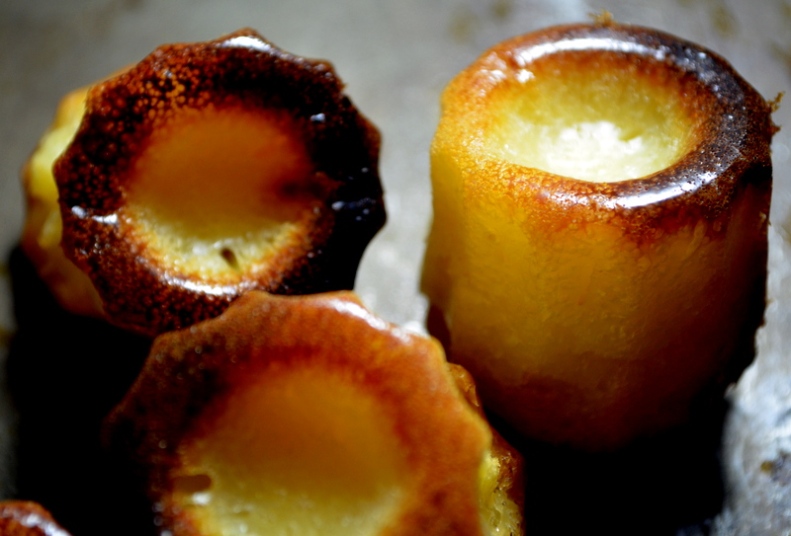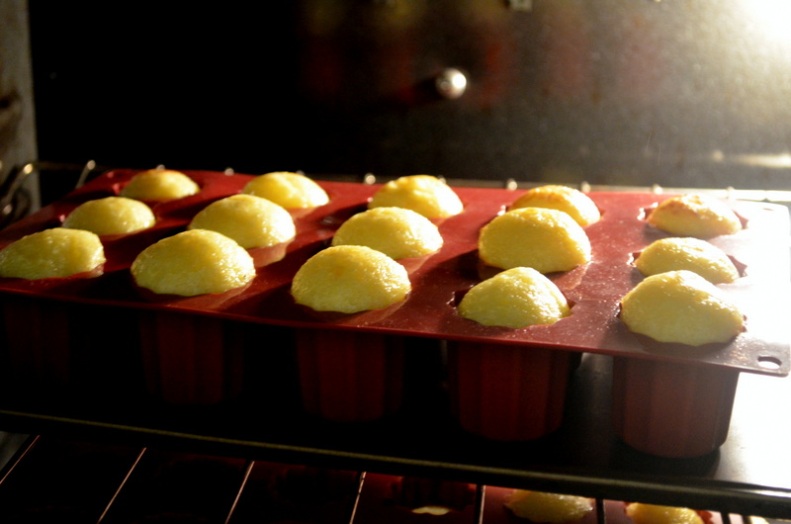Tags
Canelés, Cannelés, custard, egg, French desserts, pastries, vanilla pod
The allure of French pastries has finally cast its magic spell over me. I keep reiterating that I am not a baker, but it’s starting to look untrue. I’m just going to embrace the fact that I am evolving slowly so please be kind here.
Canelés are a pastry with an interesting history, having survived falling into almost complete obscurity for decades. Hailing from Bordeaux, they date back to the 18th century. They remained nearly extinct for centuries until the 1980s when there seemed to be a revival due to the efforts of a bunch of bakers. Lucky for me because I have fallen for them. The batter for canelés is very similar to those of crepes, which is what led me in this direction. Crispy, almost burnt on the outside, but custardy and moist on the inside, these are, quite possibly, the perfect dessert.
There a few tricks to these gems:
1. High heat
2. Try not to let air into the batter. Let it settle and settle.
3. Comparing these to their copper-molded, pastry-oven baked, beeswax-infused counterparts will yield nothing but a seed of doubt. I have enough of those. I like to hinge my contentment upon the attempt, the journey, learning from failures and the satisfaction of my successes. Best to leave comparisons to students of literature.
This recipe is culled from a combination of many different canelé recipes, but followed most closely this wonderful and comprehensive one by Clotilde of Chocolate & Zucchini.
Ingredients:
- 2 cups milk
- 2 tablespoons salted butter
- 1 vanilla pod, split, or 1 teaspoon vanilla extract
- 3/4 cup all-purpose flour
- 1 teaspoon salt
- 1 cup minus 2 tablespoons sugar
- 3 eggs
- 1/3 cup good-quality dark rum (I used Bacardi Gold)
Directions:
Combine the milk, butter and vanilla (pod or extract) in a medium saucepan, and bring to a simmer. In the meantime, combine the flour, salt, and sugar in a medium bowl. In a separate bowl, break and gently beat the eggs. When the milk mixture starts to simmer, remove from heat immediately and remove the vanilla pod if using one, and set it aside.
Pour the eggs into the flour mixture without stirring then pour in the milk mixture. Stir until well combined, trying not to incorporate too much air. Scrape the seeds from the vanilla pod with the dull side of a knife blade, and return the seeds and pod to the mixture. Add the rum and stir. Let cool to room temperature on the counter, then cover and refrigerate for at least 24 hours and up to 3 days.
In the next few days, as the air settles out of the batter, preheat the oven to 480F. (If you live in a small apartment like I do, this will set off both the smoke alarm and the fire alarm. Remove the batteries from both, making sure to return them after the baking is finished and apologize to your neighbors for making their dog go crazy if you forgot this step and assure the Super–after getting dressed when you hear a knock on the door–that there is no fire). Butter the canelé molds if you are using the copper ones (unnecessary if you’re using silicon molds). Remove the batter from the fridge: it will have separated a bit, so stir carefully until well blended again, making sure not to fill with air.
Pour into the prepared molds, filling them almost to the top. Insert into the oven for 20 minutes, then lower the heat to 400F and bake for another 30 to 40 minutes, depending on your oven and how you like your canelés. The canelés are ready when the bottoms are a very dark brown, but not burnt. They will rise during the baking process, but if you kept the air out of the batter they will flatten back out. If you feel they are darkening too fast, cover the molds with a piece of parchment paper.
Remove from oven and unmold onto a cooling rack (wait for about 10 minutes first if you’re using silicon molds or they will collapse a little) and let cool completely before eating.







Mmm, I love these, and yours look great. Love the caramelisation!
Thank you. This was my first attempt so I was really careful. I think I incorporated too much air because the bottoms never deflated, but they were SO good.
I think you are a natural baker – those look delicious 😉
Thank you, Mad Dog. It’s really shocking, but I just might be a baker. They were wonderful. I’m already planning to make another batch.
Amanda.. these are stunning and the pictures wow! 🙂
Thanks, Dimple. I wish I could send you some 🙂
Aww that would be wonderful x
Amanda, these are gorgeous! I think you are truly a talented baker. French pastry is an art and I’m impressed.
Thank you, Hannah. You always leave the nicest comments. This really is an art form. I think it can still be perfected, and I’ll try again this weekend, but these were delicious.
Well done, Amanda! Beautiful photos, too. Best, Shanna
Thanks so much, Shanna! I appreciate you stopping by 🙂
Oh, my sincere pleasure, Amanda. I will keep visiting. Best, Shanna
Wow, Amanda, these cannelés look amazing! I have never tasted cannelés, and obviously never considered making them! How that is possible, I do not know (I do live quite far from the Bordeaux area 😉 ), but I think the time has come to taste them, and perhaps give them a go myself! Bravo anyway, these look delicious!
Thanks so much. Unheard of! I just assumed all people in France have had cannel�s. I discovered them in a little French cafe across from my apartment in NY. You make me feel a little better. I was afraid to release this post since there are so many great cooks and pastry chefs that I read from France who might be like, “blasphemy!” You should make them!
Beautiful! I have never had this pastry. How nice you know how to bake them.
Thanks, Jovina. I did a lot of research. When I had one for the first time I knew I had to try it out!
Amanda, these are fantastic. We spend a bit of time in Bordeaux. I love these almost as much as I love BDX.
Best,
Conor
Thanks, Conor! Oh how I wish I can spend some time in Bordeaux too…and real French bakers can make me some caneles and coffee and wine. 🙂
Just Wonderful! One learns something worthwhile every day. Today I learned about Canelés. Your introduction and demonstration, including the photos are outstanding. Thank you Amanda!
Thanks, Fae. You’ll have to try them someday!
Ok. You got me right in the heart with this post!! I can picture the bakery where I eat these in Paris, the street & the entire neighborhood!! You knew I was gonna flip for this post didn’t you? 😉 Ms. Amanda, my gratitude for this post knows no bounds!! 🙂
Aw! Thank you. I want to have one in France one day. I knew a Cuban American in Paris would love this! Oh if you were here id give you some, but only if you brought a cortadito to drink with it! Thanks so much for saying all that 🙂
Where did you get these molds! This is one thing I’ve always been scared to try… perhaps if I knew where to get molds I’d be spurred on. Although my cat would probably freak out if the fire alarm went off.
Hi Eliza! You’re the only one who mentioned the fire alarm. I got them from amazon. http://www.amazon.com/Freshware-15-Cavity-Canneles-Silicone-Baking/dp/B004G2Q7ZA/ref=pd_sim_k_3 . You’re such a great baker, I think you should try this!
What an interesting cooking process! So new and foreign to me to allow this is set in the fridge for a few days before baking. This are so fancy and I know you must feel like you are being “treated” when you eat one. They sound amazing!
I can smell the caramel ! Stunning macro food shots. Baked custard shots.
Ah I’d send some if i could! Thanks so much. I really appreciate your comments!
I have never tasted these. I think you did a beautiful job Amanda. Your baking future looks very bright indeed!
Thank you so much. I think you would love them. You can get them in the ues on 77th st. We shall see how the baking future goes but your confidence is inspiring. Thank you. 🙂
Your photographs make these mouth watering.
Thanks, Maria. I always trying to evolve both with baking and photos.
Aren’t they stunning?! Yep, I think we can safely call you a baker now 🙂 Will have to see if I can find some little moulds to give these a try as that batter sounds delicious.
So funny. Thanks, Chica. They aren’t too sweet which is what I love. I think you’d like these.
beautiful pictures. Am impressed with your photography skills.. need to learn a few tricks from you.
Thank you, Namrata. It was a slow progression. You’ll see as you keep going with your beautiful blog. Changes sneak up on you in very cool unexpected ways. Thanks for dropping by.
stunning! I can see why they cast a spell over you 🙂
Thanks for your comment, Liz! I’m making another batch as we speak. I let the batter sit a little longer this time. I’ll have to give them away because if I eat them all, I’ll be in trouble.
Amanda, those are so gorgeous (and impressive!). I think you might have to come to terms with the fact that you might be a baker. 🙂
Thanks, Allison! Maybe one day as good as your fiancé!
Wooow, your canelés look great!!! And I know what I am talking about…being French…I used to see that delicious pastry in my favorite backery store whan I was in France…You did it great!!! Thank you for sharing Amanda.
Thanks so much. I loved making these. Stay tuned for my madeleines!
I never thought canales (my computer keeps trying to tell me these are “canals” . . . . . . were anything special, just a little spongecake or something, until I tried one last week and they were so custardlike and moist I instantly loved them. I must say the photographs belong in a book, that belongs on my coffee table. Gorgeous!!!
Thanks so much! They really are a very special pastry!